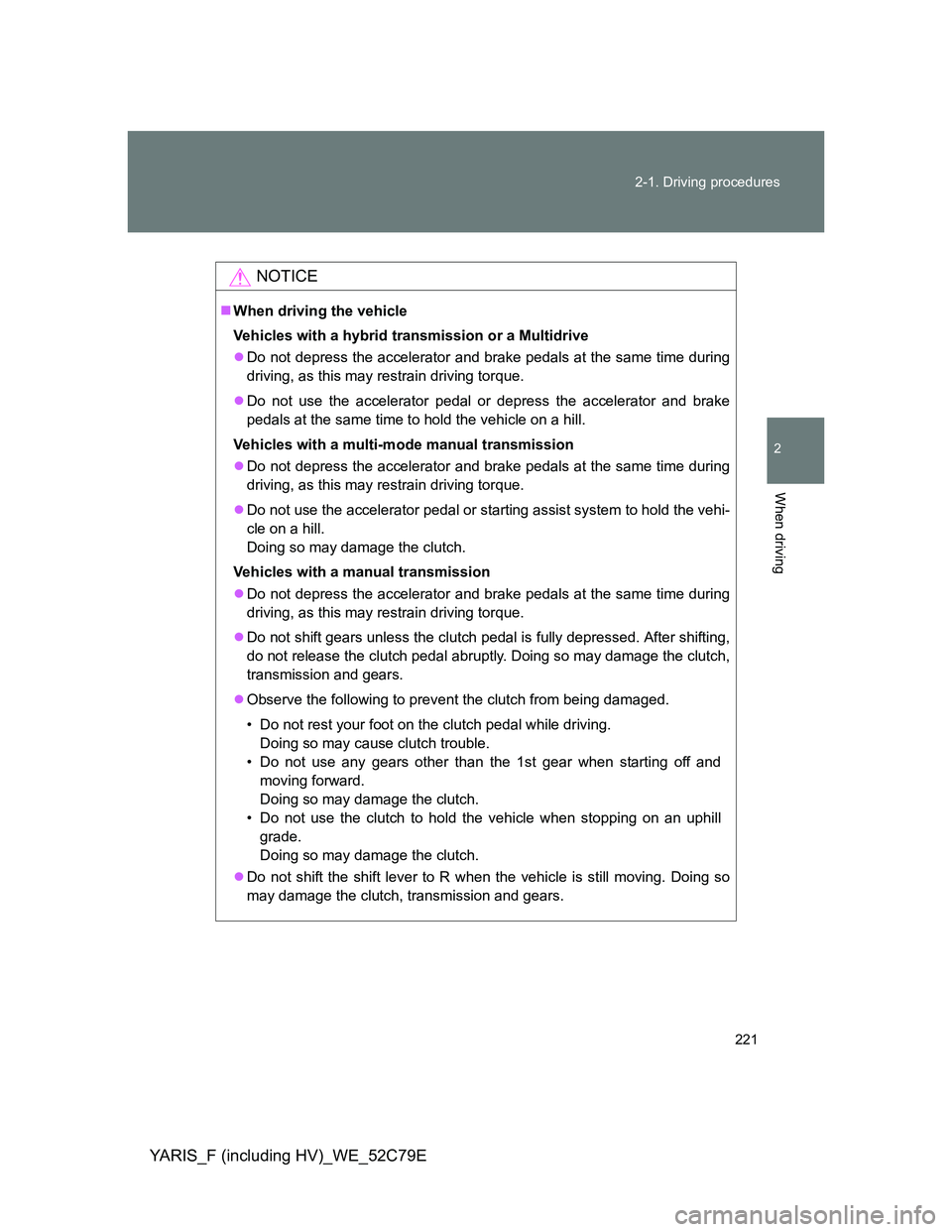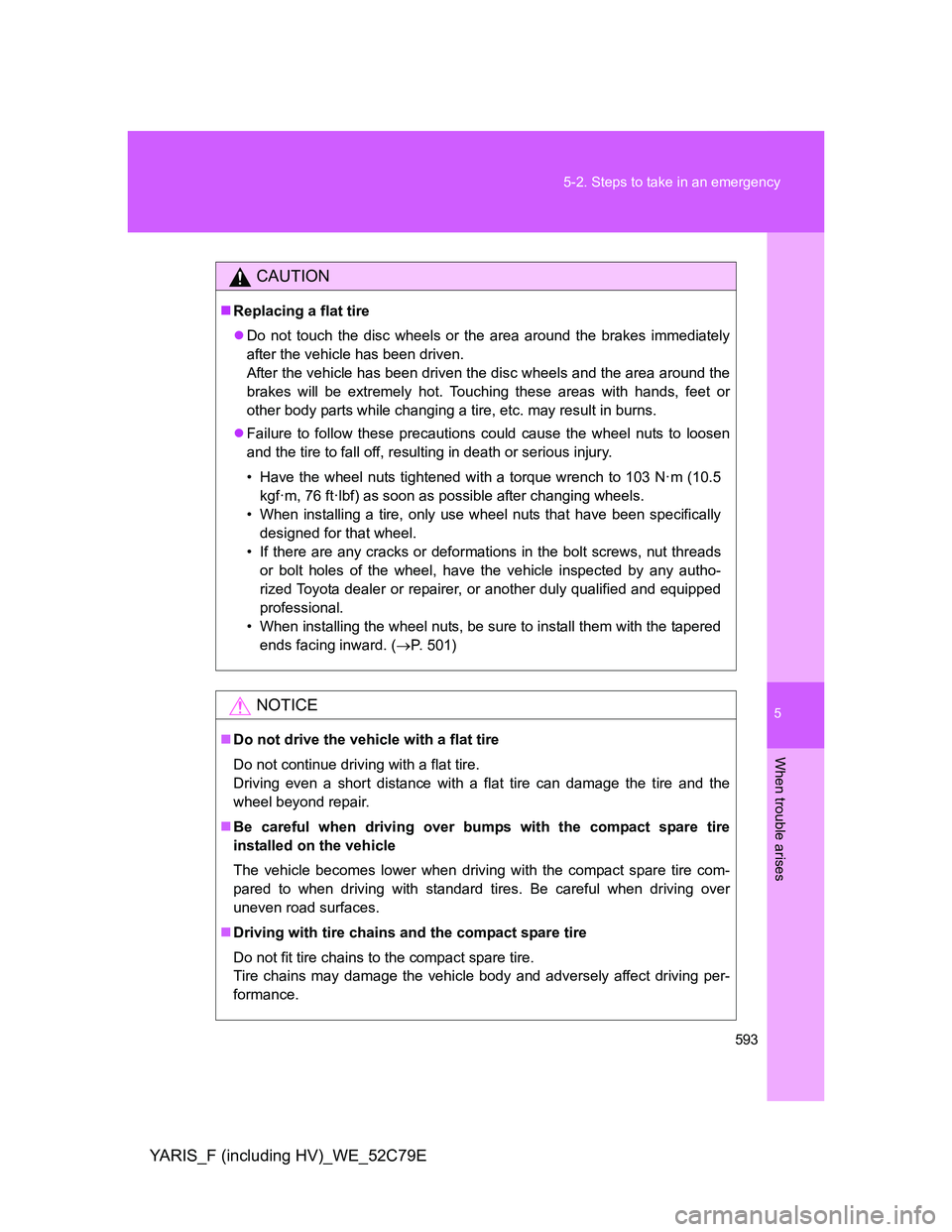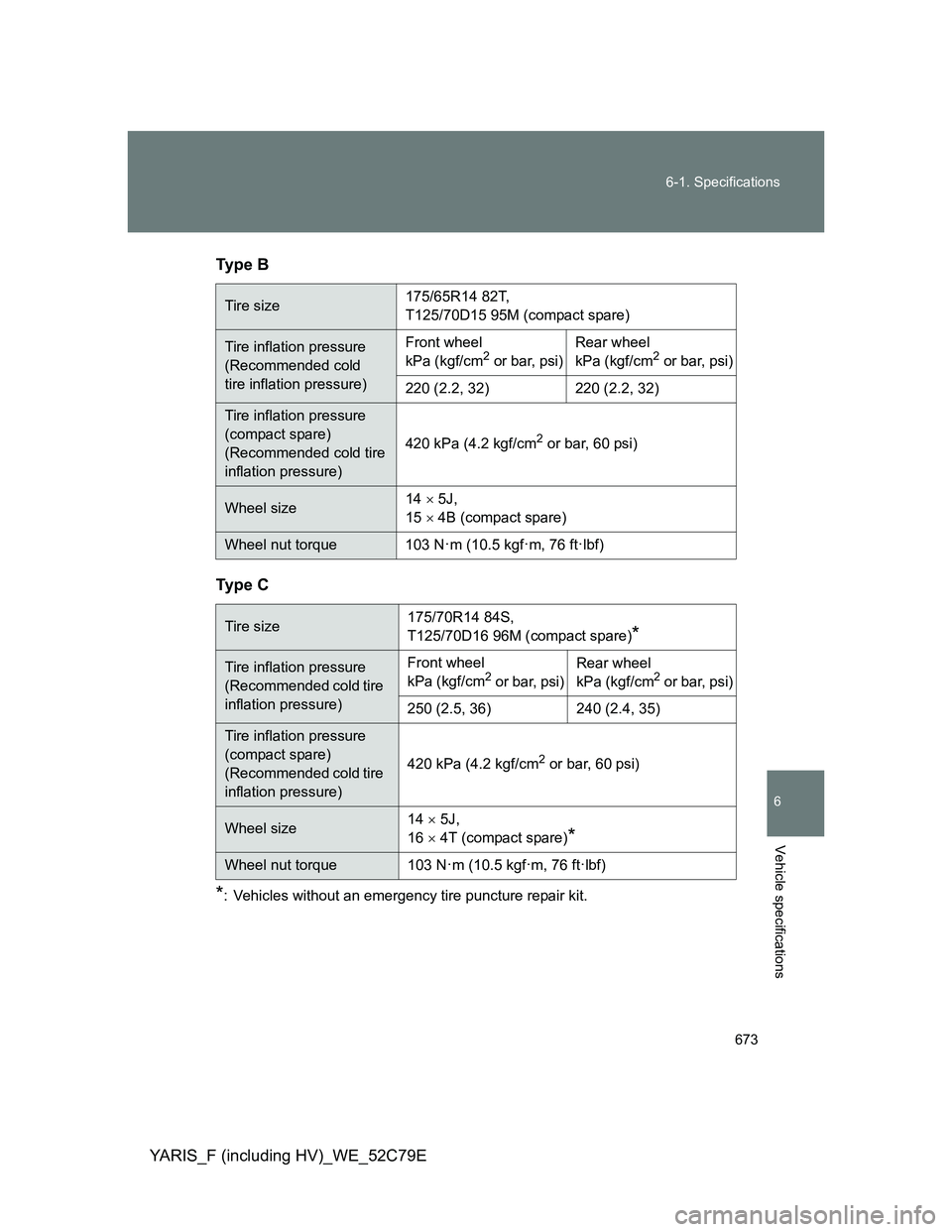Page 221 of 704

221 2-1. Driving procedures
2
When driving
YARIS_F (including HV)_WE_52C79E
NOTICE
When driving the vehicle
Vehicles with a hybrid transmission or a Multidrive
Do not depress the accelerator and brake pedals at the same time during
driving, as this may restrain driving torque.
Do not use the accelerator pedal or depress the accelerator and brake
pedals at the same time to hold the vehicle on a hill.
Vehicles with a multi-mode manual transmission
Do not depress the accelerator and brake pedals at the same time during
driving, as this may restrain driving torque.
Do not use the accelerator pedal or starting assist system to hold the vehi-
cle on a hill.
Doing so may damage the clutch.
Vehicles with a manual transmission
Do not depress the accelerator and brake pedals at the same time during
driving, as this may restrain driving torque.
Do not shift gears unless the clutch pedal is fully depressed. After shifting,
do not release the clutch pedal abruptly. Doing so may damage the clutch,
transmission and gears.
Observe the following to prevent the clutch from being damaged.
• Do not rest your foot on the clutch pedal while driving.
Doing so may cause clutch trouble.
• Do not use any gears other than the 1st gear when starting off and
moving forward.
Doing so may damage the clutch.
• Do not use the clutch to hold the vehicle when stopping on an uphill
grade.
Doing so may damage the clutch.
Do not shift the shift lever to R when the vehicle is still moving. Doing so
may damage the clutch, transmission and gears.
Page 253 of 704
253 2-1. Driving procedures
2
When driving
YARIS_F (including HV)_WE_52C79E
Shift position purpose
*: To improve fuel efficiency and reduce noises, set the shift lever in the D
position for normal driving.
Selecting Eco drive mode
Suitable for improving the fuel economy, because the torque cor-
responding to the accelerator pedal depression amount can be
generated more smoothly than it is in normal conditions and the
operation of the air conditioning system (heating/cooling) will be
minimized.
Eco drive mode
When Eco drive mode is
turned on, the “ECO MODE”
indicator will come on.
Pressing the “ECO MODE”
switch again turns Eco drive
mode off.
Shift positionFunction
PParking the vehicle/starting the hybrid system
RReversing
NNeutral
DNormal driving*
BPosition for engine braking
Page 588 of 704
588 5-2. Steps to take in an emergency
YARIS_F (including HV)_WE_52C79EWhen replacing an aluminum
wheel with an aluminum wheel,
turn the wheel nuts until the
washers come into contact with
the disc wheel.
Lower the vehicle.
Firmly tighten each wheel nut
two or three times in the order
shown in the illustration.
Tightening torque:
103 N·m (10.5 kgf·m, 76 ft·lbf)
Do not use other tools or any
additional leverage other than
your hands, such as a hammer,
pipe or your foot.
Vehicles with steel wheels
(except compact spare tire):
Reinstall the wheel ornament.
Align the cutout of the wheel
ornament with the valve stem as
shown.
Disc wheel
Washer
Page 593 of 704

5
593 5-2. Steps to take in an emergency
When trouble arises
YARIS_F (including HV)_WE_52C79E
CAUTION
Replacing a flat tire
Do not touch the disc wheels or the area around the brakes immediately
after the vehicle has been driven.
After the vehicle has been driven the disc wheels and the area around the
brakes will be extremely hot. Touching these areas with hands, feet or
other body parts while changing a tire, etc. may result in burns.
Failure to follow these precautions could cause the wheel nuts to loosen
and the tire to fall off, resulting in death or serious injury.
• Have the wheel nuts tightened with a torque wrench to 103 N·m (10.5
kgf·m, 76 ft·lbf) as soon as possible after changing wheels.
• When installing a tire, only use wheel nuts that have been specifically
designed for that wheel.
• If there are any cracks or deformations in the bolt screws, nut threads
or bolt holes of the wheel, have the vehicle inspected by any autho-
rized Toyota dealer or repairer, or another duly qualified and equipped
professional.
• When installing the wheel nuts, be sure to install them with the tapered
ends facing inward. (P. 501)
NOTICE
Do not drive the vehicle with a flat tire
Do not continue driving with a flat tire.
Driving even a short distance with a flat tire can damage the tire and the
wheel beyond repair.
Be careful when driving over bumps with the compact spare tire
installed on the vehicle
The vehicle becomes lower when driving with the compact spare tire com-
pared to when driving with standard tires. Be careful when driving over
uneven road surfaces.
Driving with tire chains and the compact spare tire
Do not fit tire chains to the compact spare tire.
Tire chains may damage the vehicle body and adversely affect driving per-
formance.
Page 661 of 704
661 6-1. Specifications
6
Vehicle specifications
YARIS_F (including HV)_WE_52C79EDiesel engine
Electric motor (Traction motor)
Fuel typeEU area:
Diesel fuel conforming to European standard
EN590
Except EU area:
Diesel fuel that contains 50 ppm or less of sulfur
Cetane number 48 or higher
Fuel tank capacity
(Reference)42 L (11.1 gal., 9.2 Imp. gal.)
Type Permanent magnet motor
Maximum output 45 kW
Maximum torque 169 N·m (17.2 kgf·m, 125 ft·lbf)
Page 672 of 704
672 6-1. Specifications
YARIS_F (including HV)_WE_52C79EHybrid vehicle
*1: Minimum pedal clearance when depressed with a force of 300 N (31 kgf,
67.4 lbf) while the engine is running
*2: Parking brake lever travel when pulled up with a force of 200 N (20.4 kgf,
45.0 lbf)
Steering
Tires and wheels
Ty p e A
Pedal clearance*170 mm (2.8 in.)
Pedal free play 1 — 6 mm (0.04 — 0.24 in.)
Parking brake lever travel*24 — 6 clicks
Fluid type SAE J1704 or FMVSS No.116 DOT 4
Free play Less than 30 mm (1.2 in.)
Tire size 175/65R14 82T
Tire inflation pressure
(Recommended cold
tire inflation pressure)Front wheel
kPa (kgf/cm2 or bar, psi)Rear wheel
kPa (kgf/cm2 or bar, psi)
220 (2.2, 32) 220 (2.2, 32)
Wheel size 14 5J
Wheel nut torque 103 N·m (10.5 kgf·m, 76 ft·lbf)
Page 673 of 704

673 6-1. Specifications
6
Vehicle specifications
YARIS_F (including HV)_WE_52C79ETy p e B
Ty p e C
*: Vehicles without an emergency tire puncture repair kit.
Tire size175/65R14 82T,
T125/70D15 95M (compact spare)
Tire inflation pressure
(Recommended cold
tire inflation pressure)Front wheel
kPa (kgf/cm2 or bar, psi)Rear wheel
kPa (kgf/cm2 or bar, psi)
220 (2.2, 32) 220 (2.2, 32)
Tire inflation pressure
(compact spare)
(Recommended cold tire
inflation pressure)420 kPa (4.2 kgf/cm
2 or bar, 60 psi)
Wheel size14 5J,
15 4B (compact spare)
Wheel nut torque 103 N·m (10.5 kgf·m, 76 ft·lbf)
Tire size175/70R14 84S,
T125/70D16 96M (compact spare)*
Tire inflation pressure
(Recommended cold tire
inflation pressure)Front wheel
kPa (kgf/cm2 or bar, psi)Rear wheel
kPa (kgf/cm2 or bar, psi)
250 (2.5, 36) 240 (2.4, 35)
Tire inflation pressure
(compact spare)
(Recommended cold tire
inflation pressure)420 kPa (4.2 kgf/cm
2 or bar, 60 psi)
Wheel size14 5J,
16 4T (compact spare)*
Wheel nut torque 103 N·m (10.5 kgf·m, 76 ft·lbf)
Page 674 of 704
674 6-1. Specifications
YARIS_F (including HV)_WE_52C79ETy p e D
*1: Vehicles without an emergency tire puncture repair kit.
*2: For some models, ECO tire pressure is shown on the tire pressure label.
(P. 602)
“For optimizing fuel economy, ECO tire pressure is recommended.
Tire pressure affects traveling comfort, road noise and steering characteris-
tics.”
Tire size175/65R15 84H,
T125/70D16 96M (compact spare)*1
Tire inflation pressure
(Recommended cold tire
inflation pressure)Front wheel
kPa (kgf/cm
2 or bar,
psi)Rear wheel
kPa (kgf/cm2 or bar,
psi)
Standard tire pres-
sure: 230 (2.3, 33)
ECO tire pressure
*2:
250 (2.5, 36)Standard tire pres-
sure: 220 (2.2, 32)
ECO tire pressure*2:
240 (2.4, 35)
Tire inflation pressure
(compact spare)
(Recommended cold tire
inflation pressure)420 kPa (4.2 kgf/cm
2 or bar, 60 psi)
Wheel size15 5J,
16 4T (compact spare)*1
Wheel nut torque 103 N·m (10.5 kgf·m, 76 ft·lbf)